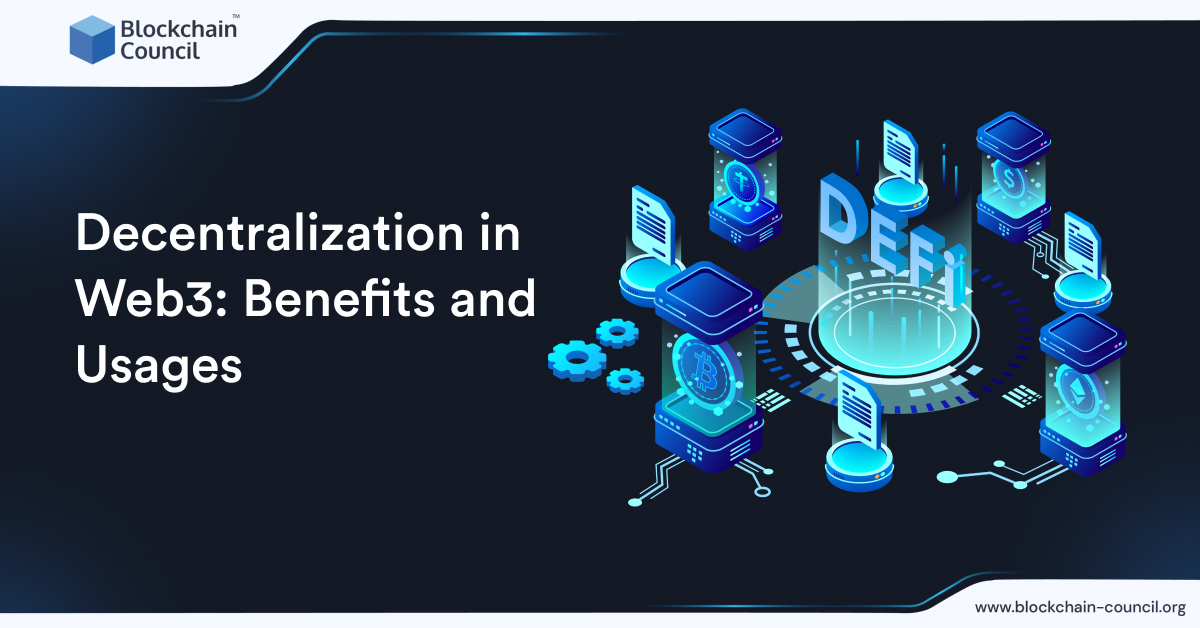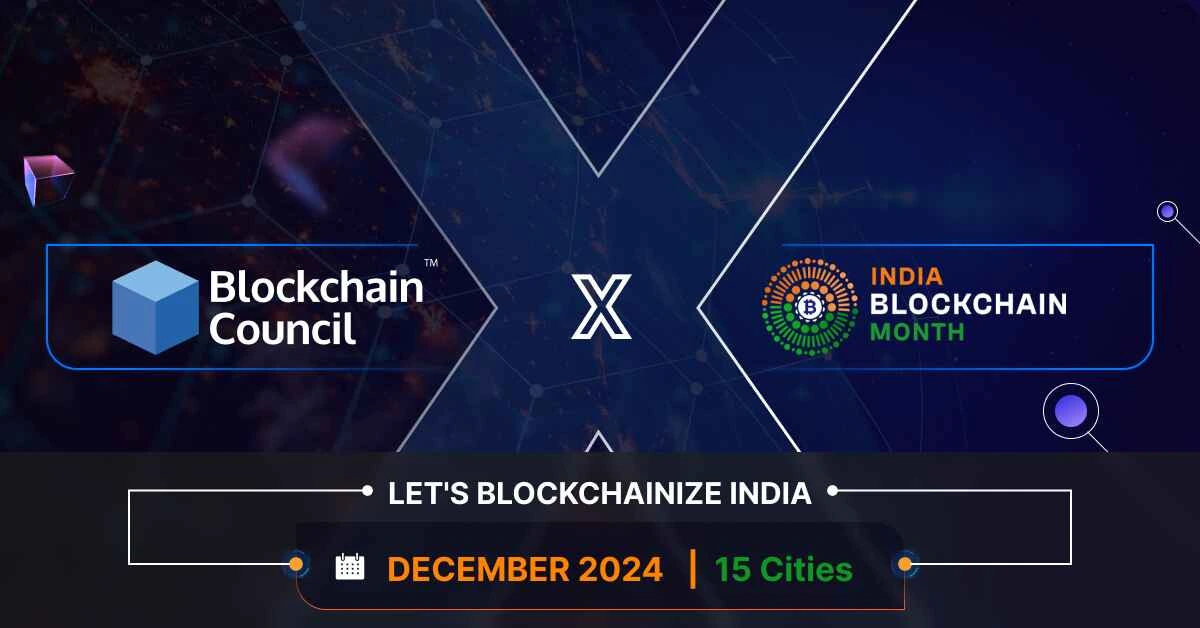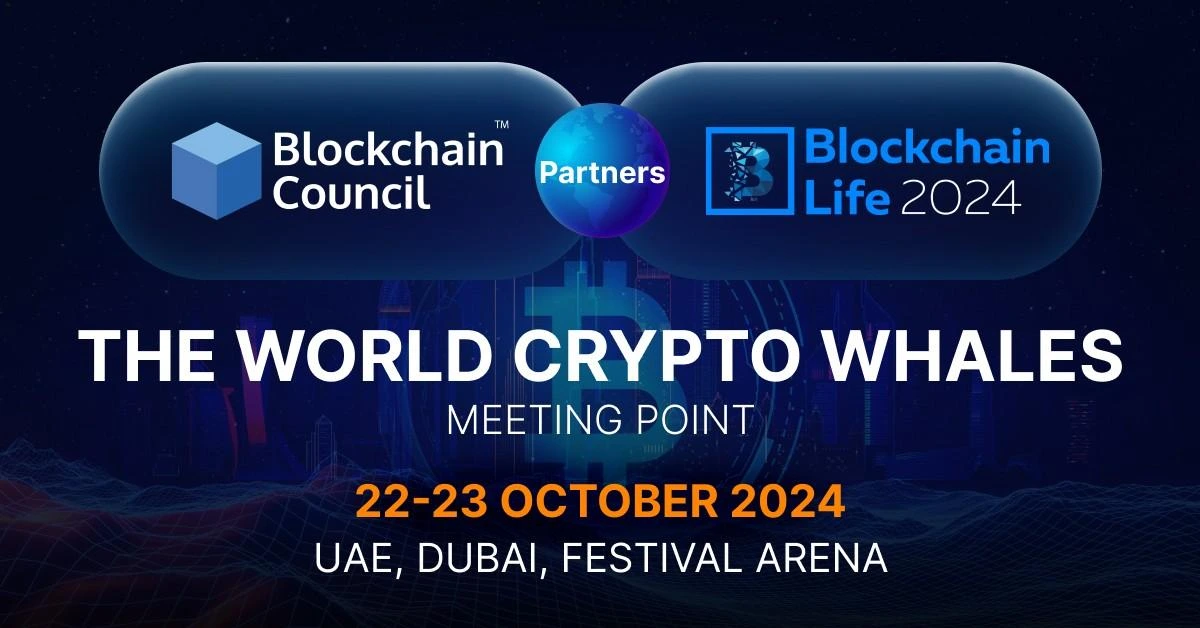
Blockchain Council Partners with Consensus Hong Kong 2025
Blockchain Council is excited to join Consensus Hong Kong 2025 as a Community Partner. This event is one of the biggest gatherings for Blockchain, digital

The third generation of the internet, or Web3, is currently under development. With the implementation of advanced technologies such as artificial intelligence (AI), machine learning (ML), big data, and decentralized ledger technology (DLT), websites and apps will have the capability to analyze data in a manner that resembles human intelligence.
For the uninitiated, Web3 is a collection of decentralized innovations that serve as the foundation for the next phase. Blockchain, the decentralized web, dApps, DeFi, DAOs, cryptocurrencies, creator economy, and DDNs are some of the ideas and technologies represented by Web3. Let’s discuss decentralization in Web3 in detail.
Decentralization in Web3 involves setting up key infrastructure components, like storage, in a strong, worldwide network. This prevents any individual or organization from restricting or controlling access. This is a fundamental tenet of public Blockchain infrastructure and a crucial Web3 design concept.
A decentralized network is characterized by having multiple authorities serving as central hubs for its participants. Decentralized network architectures are used in computing to spread tasks among many computers instead of simply depending on a central server.
With built-in economic incentives, permissionless networks will pave the way for new-age finance. DeFi will allow everyone to access Blockchain technology and maintain finances without the assistance of a single firm or central authority.
An upcoming Web3 idea, decentralized identity, is built on a trust framework for identity management. An identity and access management method that enables people to create, maintain, or control their personally identifiable information (PII) even without the help of a centralized third party into a registry, identity provider, and certification authority is known as decentralized identity management.
Blockchain is frequently used in decentralized data storage devices to monitor storage transactions. Blockchain can efficiently integrate and verify storage transactions between dispersed nodes.
The decentralization of business models is the primary characteristic of Web3. In that sense, it brings in a third stage of the internet (thus the name “Web3”) or changes users’ perceptions of the status quo. Before Web3, user information, such as identity and transaction history, including credit ratings, was gathered and resold in a centralized manner, replacing the original open protocols of the 1980s web, where innovation was open to anyone.
Due to the issue of centralization, applications are developed, supplied, and monetized in a proprietary manner; a small group makes all operational and governing decisions of people, and profits are split between shareholders and management.
With the assurance of safe and secure transfers provided by a Blockchain, network participants now trust more. Furthermore, because of Blockchain’s openness, everyone on the network can view such transfers in real-time. Accountability and trust between company partners are enhanced in the presence.
One of the main issues with any Blockchain system is security. Public Blockchains lack service level agreements (SLAs), which centralized cloud providers legally provide to all of their consumers and often range in the 99.9% uptime range. Consequently, if a Blockchain is “down,” all online transactions and activity could stand at a standstill.
The issues of trust and transparency are important concerns as well. Simple and intuitive interfaces which enable users to comprehend what details they are providing with web service providers will be needed if Web3 promises that consumers will have more control over their data. Decentralized identity, also known as Self-Sovereign Identity, is a framework that aims to provide users with centralized authority over their identities and related details.
Web3 is still developing, yet it has already started to upend industries as diverse as the financial and art industries. While banks struggle to comprehend the meanings of Web3 and DeFi (Decentralised Finance), artists and other content creators are constantly coming up with new ways to interact and communicate with their audiences. The education industry will need to adjust as the Web2 transition becomes more widespread.
Assets can be freely and immediately traded peer-to-peer in a Web3-powered metaverse without intermediaries. Here is a short and precise overview of different digital assets in Web3:
The decentralized Web3 concept is being accomplished via a new category of cryptocurrency known as Web3 cryptos. They combine Blockchain technology using smart contracts to facilitate transactions without middlemen or to give users control over their data.
NFTs are tokens you can use to indicate ownership of certain goods. Thanks to them, we can tokenize items like works of art, valuables, and even real estate. NFTs guarantee asset ownership since no one can change the ownership record and copy/paste a new NFT into existence. Your furniture, a song file, or a computer could all be considered non-fungible in economics. Due to their distinctive characteristics, they cannot substitute some things for other items.
Stablecoins were developed by producing a cryptocurrency token pegged with a fiat currency price. To attain this stability, the token is linked to an asset, such as gold or fiat money. Coins are primarily viewed as speculative investments due to the long- and short-term volatility of cryptocurrencies. Markets are more confident in stablecoin prices when more traditional investments support them. Stablecoins are frequently chosen as the preferred alternative for financial decisions by retail and institutional cryptocurrency users.
Users can trade cryptocurrencies on a DEX (decentralized exchange) in a non-custodial manner, even without requiring a middleman to handle the transfer and custody of funds. To support the exchange of assets, DEXs use Blockchain-based smart contracts instead of conventional intermediaries like banks, brokers, payment processors, and other organizations.
If you want to get a complete understanding of digital assets and how they can be used to build scalable Web3 ecosystems, Blockchain Council is here to help you with a series of courses and certifications developed by industry experts and professionals. Learn about digital assets like NFTs and cryptocurrencies in detail with Blockchain Council Cryptocurrency Expert and NFT Expert certification.
There is evident interest in this expanding industry when Web3 adoption is examined through the lenses of culture, money, community, and consumption. Here are some fields that will see an increase in Web3 adoption:
The future of education with Web3 technologies holds tremendous potential to revolutionize how we learn and teach. Decentralized learning platforms powered by Blockchain technology can offer new possibilities for secure, transparent, and cost-effective education.
Students will have more control over their data and personal information and can authenticate their degrees and certifications in a tamper-proof manner. Web3 technologies can also enable new collaboration and peer-to-peer learning models, breaking down barriers and promoting greater access to education globally.
The regulation of Web3 technologies in the future will play a crucial role in shaping the growth and adoption of decentralized systems. Governments and regulatory bodies will need to balance the need for security, privacy, and consumer protection with the innovative potential of these technologies. Clear and consistent guidelines and regulations will be necessary to ensure the ethical use of decentralized systems and prevent malicious actors from exploiting the technology. The development of Web3 technologies will require ongoing collaboration between stakeholders to establish best practices and promote responsible innovation.
Web3’s revolutionary premise is based on three key elements: the Blockchain ledger, which records all information regarding asset ownership and the history of completed transactions; “smart” contracts, which reflect application logic and can carry out specific tasks independently; and digital assets, which can represent anything of value as well as interact with smart contracts into becoming “programmable.” Web3 enables developers to develop distributed applications (dApps).
Blockchain technology allows these decentralized applications (dApps) to function independently of a centralized authority. As a result, users can communicate without disclosing personal information and are less vulnerable to censorship. Decentralization can bring advantages, such as improved security, enhanced resistance to attacks or malfunctions, and more equitable allocation of authority and resources. It has been used in many situations, such as developing peer-to-peer networks, dispersed computing systems, and Blockchain and cryptocurrency mechanisms.

Blockchain Council is excited to join Consensus Hong Kong 2025 as a Community Partner. This event is one of the biggest gatherings for Blockchain, digital

Blockchain Council is excited to share that it will be the Community Partner for Consensus Hong Kong 2025, an event widely regarded as one of

Blockchain technology is bringing fresh perspectives to how people engage with digital tools. It’s opening new doors for industries, creating possibilities, and uplifting communities. With

The Blockchain Council is thrilled to announce its media partnership with Blockchain Life 2024, one of the key events in the Blockchain and cryptocurrency space.

Blockchain Council is excited to announce its official media partnership with Blockchain Life 2024, the premier blockchain and cryptocurrency event of the year. Scheduled to
Web3 is the third generation of the internet, currently under development, and will allow websites and apps to analyze data in a manner that resembles human intelligence. It is a collection of decentralized innovations such as Blockchain, the decentralized web, dApps, DeFi, DAOs, cryptocurrencies, creator economy, and DDNs.
Decentralization brings several benefits to Web3 and its users. One of the most significant benefits is that decentralization eliminates the need for a central authority or intermediary to control and regulate transactions. With Web3, users have complete control over their data and assets, and no one can access or manipulate them without permission. This enhances security and privacy, and it also makes the platform more transparent and accessible to a wider range of users.
Decentralization in Web3 involves setting up key infrastructure components like storage in a strong, worldwide network to prevent any individual or organization from restricting or controlling access. Decentralization in Web3 can bring a third stage of the internet, changes users’ perceptions of the status quo, and revolutionizes traditional industries by improving transparency and security, empowering individuals, and enabling decentralized finance, identity, and storage.
Digital assets in Web3 include cryptos, NFTs, stablecoins, and decentralized exchanges that allow for peer-to-peer transactions and ownership verification without intermediaries. Cryptocurrencies use Blockchain technology and smart contracts. NFTs indicate ownership of specific goods. Stablecoins are cryptocurrency tokens pegged to fiat currencies. Decentralized exchanges allow users to trade cryptocurrencies in a non-custodial manner.
Welcome to the Blockchain Council, a collective of forward-thinking Blockchain and Deep Tech enthusiasts dedicated to advancing research, development, and practical applications of Blockchain, AI, and Web3 technologies. Our mission is to foster a collaborative environment where experts from diverse disciplines share their knowledge and promote varied use cases for a technologically advanced world.
Blockchain Council is a private de-facto organization of experts and enthusiasts championing advancements in Blockchain, AI, and Web3 Technologies. To enhance our community’s learning, we conduct frequent webinars, training sessions, seminars, and events and offer certification programs.
To receive Offers & Newsletters
60,000+ Professionals Certified so far by Blockchain Council

Coupon
expires in
Enroll today in any of the popular certifications curated as per the Industry trends.
